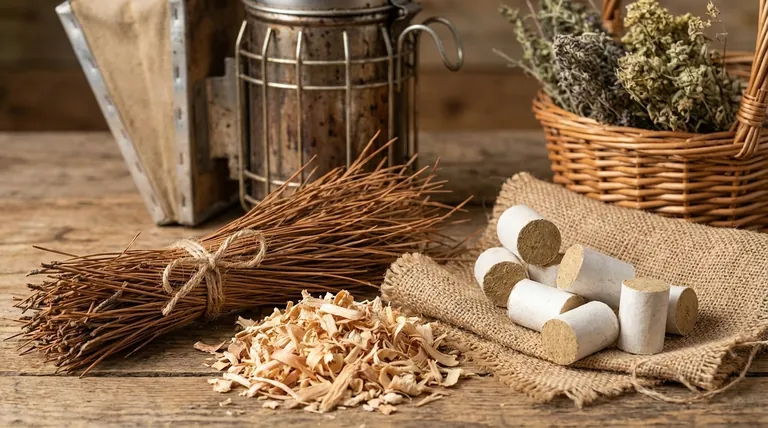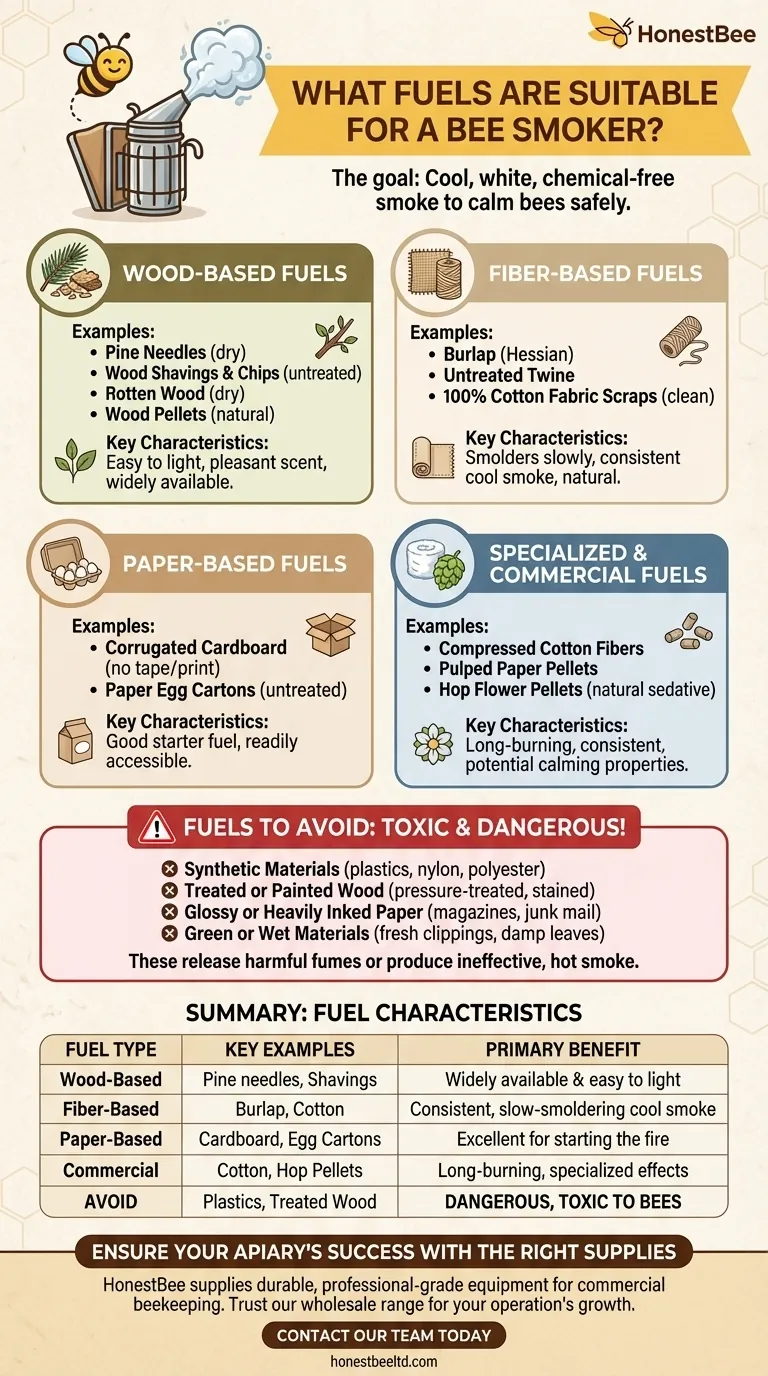The best fuels for a bee smoker are natural, untreated materials that smolder slowly to produce a cool, white smoke. Common and highly effective options include pine needles, wood shavings, burlap, and specialized smoker fuels made from compressed cotton. The essential requirement is that the fuel is free from any chemicals, synthetics, or contaminants that could harm the bees.
The critical factor in choosing a smoker fuel is not the specific material, but its purity. The primary goal is to create a long-lasting, cool smoke from a completely natural source to calm the bees safely and effectively.

The Principles of an Effective Smoker Fuel
To understand which fuels work best, it's important to grasp what you are trying to achieve. The smoke masks the bees' alarm pheromones, making them less defensive and easier to manage during a hive inspection.
Natural and Chemical-Free is Non-Negotiable
The health of your colony is paramount. Bees are highly sensitive to chemicals, and burning materials treated with pesticides, paint, glue, or other synthetic compounds can be toxic.
Always ensure your fuel source is clean and untreated.
The Goal is Cool, Dense Smoke
A hot fire with open flames is counterproductive and dangerous. You want a slow, smoldering burn that produces thick, cool, white smoke.
This type of smoke effectively pacifies the bees without agitating them or posing a fire risk to the hive components.
A Slow and Steady Burn is Key
A good fuel should last for the duration of your inspection without needing constant attention. Materials that burn too quickly will require you to stop and reload the smoker, disrupting your workflow.
Common and Reliable Fuel Categories
Beekeepers have successfully used a wide variety of materials. Your choice will often come down to what is readily and safely available in your area.
Wood-Based Fuels
These are often the most accessible options. They include materials like dry pine needles, wood shavings or chips, wood pellets, and even dry, rotten wood.
Pine needles are a classic choice as they light easily and produce a pleasant-smelling smoke.
Fiber-Based Fuels
Natural fibers are excellent for smoldering and producing consistent smoke. Popular choices include burlap (also known as Hessian fabric), untreated twine, and scraps of 100% cotton fabric like old t-shirts.
When using fabric, be absolutely certain it is a natural fiber and not a synthetic blend.
Paper-Based Fuels
Certain paper products are suitable, provided they are untreated. Corrugated cardboard (with no glossy print or tape) and paper egg cartons are common choices.
These materials are often used as a starter to get the fire going before adding longer-burning fuels on top.
Specialized and Commercial Fuels
For convenience and consistency, many beekeepers use commercial fuels. These are typically made from compressed cotton fibers or pulped paper and are designed to be long-burning and safe.
An interesting and highly effective option is pellets made from the dried female hop flower, which contains the natural sedative lupulin.
Common Pitfalls and Fuels to Avoid
Using the wrong fuel is one of the most dangerous mistakes a beekeeper can make. It can harm your bees, your equipment, and yourself.
Synthetic Materials
Never burn plastics, nylon, polyester, or other synthetic fabrics. These materials release toxic fumes that are harmful to you and lethal to your bees.
Treated or Painted Wood
Avoid any wood that has been pressure-treated, painted, stained, or varnished. These treatments contain heavy metals and chemicals that become airborne when burned.
Glossy or Heavily Inked Paper
Magazines, junk mail, and printed cardboard often contain chemical-based inks, clays, and glues. Burning these can release harmful compounds into the hive.
Green or Wet Materials
Using green leaves, fresh grass clippings, or damp fuel is ineffective. These materials produce a hot, steamy smoke rather than a cool, calming one, and they are difficult to keep lit.
Making the Right Choice for Your Goal
Your choice of fuel will depend on availability, cost, and personal preference. All of the recommended options will work well if used correctly.
- If your primary focus is accessibility and low cost: Use readily available materials like dry pine needles, untreated cardboard egg cartons, or wood shavings from a clean source.
- If your primary focus is a long, consistent burn: Opt for denser materials like burlap, commercial compressed cotton fuel, or hardwood pellets.
- If your primary focus is maximum calming effect: Consider sourcing specialized pellets made from dried hop flowers for their natural sedative properties.
Ultimately, a safe and effective inspection is achieved by using any clean, dry, natural fuel that you can reliably keep smoldering.
Summary Table:
| Fuel Type | Examples | Key Characteristics |
|---|---|---|
| Wood-Based | Pine needles, wood shavings, rotten wood | Easy to light, pleasant smoke, widely available |
| Fiber-Based | Burlap, untreated cotton fabric | Smolders slowly, produces consistent, cool smoke |
| Paper-Based | Corrugated cardboard, paper egg cartons | Good for starting the fire; ensure it's untreated |
| Commercial/Specialized | Compressed cotton, hop pellets | Long-burning, consistent, some have calming properties |
| Fuels to AVOID | Plastics, treated/painted wood, synthetic fabrics | Release toxic fumes that are harmful or lethal to bees |
Ensure Your Apiary's Success with the Right Supplies
Managing a commercial operation requires reliable, high-quality equipment. Using the correct, safe fuel for your bee smoker is just one part of effective hive management. HONESTBEE supplies beekeepers and beekeeping equipment distributors with the durable, professional-grade supplies needed for success.
We understand the demands of commercial apiaries and offer a wholesale-focused range of products you can trust.
Ready to equip your business with the best? Contact our team today to discuss your needs and discover how we can support your operation's growth and efficiency.
Visual Guide

Related Products
- 54-Piece Smoker Fuel Pellets for Beekeeping Beehive Smoker Fuel
- Stainless Steel Honey Bee Smoker Hive and Honeycomb Smoker for Beekeeping
- Economy Galvanized Beekeeping Honey Bee Smoker for Wholesale
- Premium Traditional Copper Bee Smoker with Bellows
- European Stainless Steel Bee Smoker for Honey Bee Hive
People Also Ask
- What is the best material for a bee smoker? Choose the Right Fuel for a Calm Hive
- What is best to burn in a bee smoker? Master the Layered Fuel Technique for Calm Hives
- What can I use for bee smoker fuel? Choose Safe, Natural Materials for a Calm Hive
- What is the best bee hive smoker fuel? Choose Natural, Slow-Burning Fuel for Calm Bees
- What to put in a bee hive smoker? A Guide to Natural, Calming Fuels



















